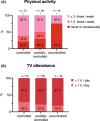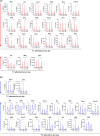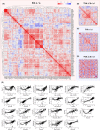Physical activity in asthma control and its immune modulatory effect in asthmatic preschoolers
- PMID: 34547110
- PMCID: PMC9291774
- DOI: 10.1111/all.15105
Physical activity in asthma control and its immune modulatory effect in asthmatic preschoolers
Abstract
Background: The impact of physical activity on immune response is a hot topic in exercise immunology, but studies involving asthmatic children are scarce. Our aims were to examine whether there were any differences in the level of physical activity and daily TV attendance, to assess its role on asthma control and immune responses to various immune stimulants.
Methods: Weekly physical activity and daily television attendance were obtained from questionnaires at inclusion of the PreDicta study. PBMC cultures were stimulated with phytohemagglutinin (PHA), R848, poly I:C, and zymosan. A panel of cytokines was measured and quantified in cell culture supernatants using luminometric multiplex immunofluorescence beads-based assay.
Results: Asthmatic preschoolers showed significantly more TV attendance than their healthy peers (58.6% vs. 41.5% 1-3 h daily and only 25.7% vs. 47.2% ≤1 h daily) and poor asthma control was associated with less frequent physical activity (PA) (75% no or occasional activity in uncontrolled vs. 20% in controlled asthma; 25% ≥3 times weekly vs. 62%). Asthmatics with increased PA exhibited elevated cytokine levels in response to polyclonal stimulants, suggesting a readiness of circulating immune cells for type 1, 2, and 17 cytokine release compared to subjects with low PA and high TV attendance. This may also represent a proinflammatory state in high PA asthmatic children. Low physical activity and high TV attendance were associated with a decrease in proinflammatory cytokines. Proinflammatory cytokines were correlating with each other in in vitro immune responses of asthmatic children, but not healthy controls, this correlation was more pronounced in children with sedentary behavior.
Conclusion: Asthmatic children show more sedentary behavior than healthy subjects, while poor asthma control is associated with a substantial decrease in physical activity. Our results suggest that asthmatic children may profit from regular exercise, as elevated cytokine levels in stimulated conditions indicate an immune system prepared for responding strongly in case of different types of infections. However, it has to be considered that a hyperinflammatory state in high PA may not be beneficial in asthmatic children.
Keywords: PreDicta; asthma; cytokines; immune modulation; physical activity.
© 2021 The Authors. Allergy published by European Academy of Allergy and Clinical Immunology and John Wiley & Sons Ltd.
Conflict of interest statement
DJM, CL, SF, YG, AG, TJ, WK, HL, BS, GT, MV, LZ, NZ, and MA have nothing to disclose. PX reports personal fees from Uriach, Novartis, Néstle, and Nutricia outside the submitted work. MP reports grants from University of Athens during the conduct of the study and personal fees from Aimmune Therapeutics, grants from Hellenic Society of Allergy and Clinical Immunology outside the submitted work. NP reports personal fees from Novartis, Nutricia, HAL, MENARINI/FAES FARMA, SANOFI, MYLAN/MEDA, BIOMAY, AstraZeneca, GSK, MSD, ASIT BIOTECH, Boehringer Ingelheim, grants from Gerolymatos International SA, Capricare outside the submitted work. CA reports grants form Allergopharma, Idorsia, Swiss National Science Foundation, Christine Kühne‐Center for Allergy Research and Education, European Commission's Horison's 2020 Framework Programme, Cure, Novartis Research Institutes, Astra Zeneca, SciBase advisory role and is on the advisory board for Sanofi/Regeneron, GSK, Novartis. CB received honoraria from ALK, Astra‐Zeneca, GSK, Novartis, and Sanofi outside of this work.
Figures






Similar articles
-
Effect of Haemophilus influenzae, Streptococcus pneumoniae and influenza vaccinations on infections, immune response and asthma control in preschool children with asthma.Allergy. 2023 Jun;78(6):1473-1488. doi: 10.1111/all.15551. Epub 2022 Oct 26. Allergy. 2023. PMID: 36229409
-
Peripheral blood mononuclear cells from severe asthmatic children release lower amounts of IL-12 and IL-4 after LPS stimulation.Allergol Immunopathol (Madr). 2015 Sep-Oct;43(5):482-6. doi: 10.1016/j.aller.2014.10.005. Epub 2015 May 16. Allergol Immunopathol (Madr). 2015. PMID: 25985710
-
Allergen-induced cytokine secretion in atopic and non-atopic asthmatic children.Pediatr Allergy Immunol. 2003 Oct;14(5):345-50. doi: 10.1034/j.1399-3038.2003.00061.x. Pediatr Allergy Immunol. 2003. PMID: 14641603 Clinical Trial.
-
Rhinovirus-Induced Cytokine Alterations With Potential Implications in Asthma Exacerbations: A Systematic Review and Meta-Analysis.Front Immunol. 2022 Feb 15;13:782936. doi: 10.3389/fimmu.2022.782936. eCollection 2022. Front Immunol. 2022. PMID: 35242128 Free PMC article.
-
COVID-19 Pandemic and Reduced Physical Activity: Is There an Impact on Healthy and Asthmatic Children?Front Pediatr. 2021 Sep 8;9:695703. doi: 10.3389/fped.2021.695703. eCollection 2021. Front Pediatr. 2021. PMID: 34568238 Free PMC article. Review.
Cited by
-
Sedentary behaviors, physical activity, and risk of allergic rhinitis and asthma: evidence from cohort and Mendelian randomization studies.BMC Pulm Med. 2025 Jul 3;25(1):320. doi: 10.1186/s12890-025-03779-7. BMC Pulm Med. 2025. PMID: 40611016 Free PMC article.
-
Immune-inflammatory proteome of elite ice hockey players before and after SARS-CoV-2 infection.Allergy. 2022 Oct;77(10):3144-3147. doi: 10.1111/all.15405. Epub 2022 Jun 25. Allergy. 2022. PMID: 35690999 Free PMC article. No abstract available.
-
Exercise Recommendations and Practical Considerations for Asthma Management-An EAACI Position Paper.Allergy. 2025 Jun;80(6):1572-1591. doi: 10.1111/all.16573. Epub 2025 May 6. Allergy. 2025. PMID: 40327018 Free PMC article.
References
-
- Asher I, Pearce N. Global burden of asthma among children. Int J Tuberc Lung Dis. 2014;18(11):1269‐1278. - PubMed
-
- Welsh L, Roberts RG, Kemp JG. Fitness and physical activity in children with asthma. Sports Med. 2004;34(13):861‐870. - PubMed
-
- Berntsen S, Carlsen KC, Anderssen SA, et al. Norwegian adolescents with asthma are physical active and fit. Allergy. 2009;64(3):421‐426. - PubMed

